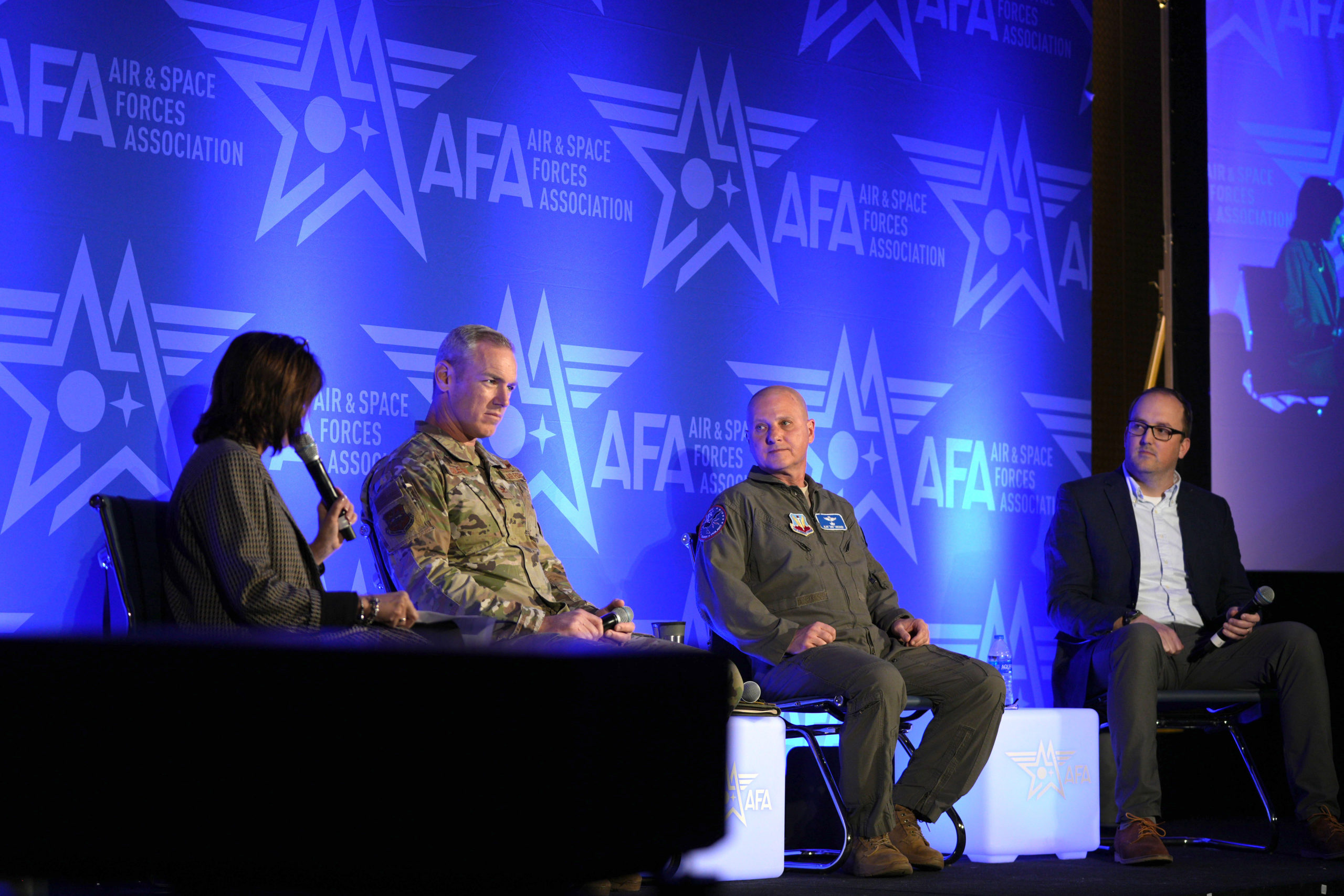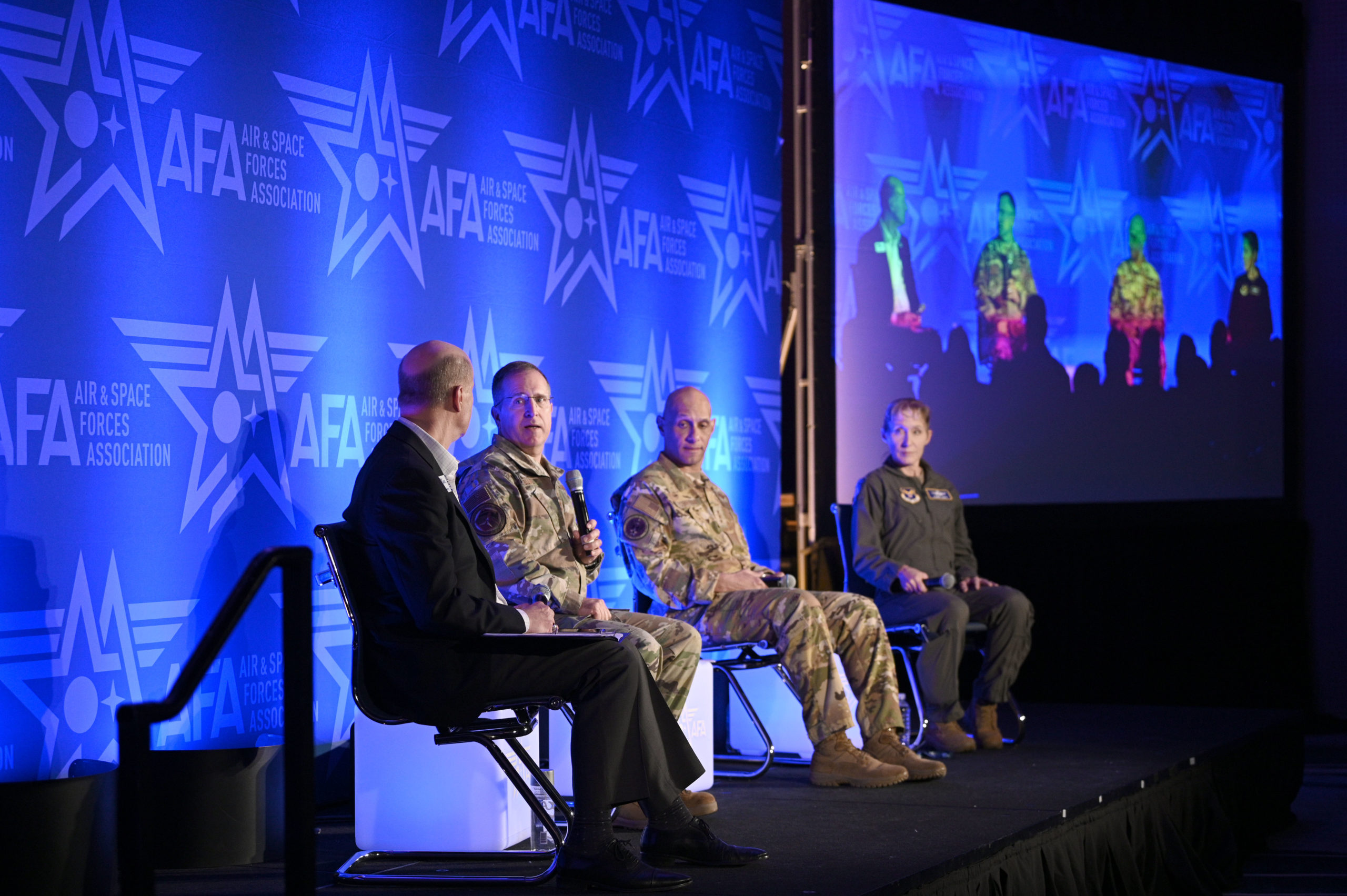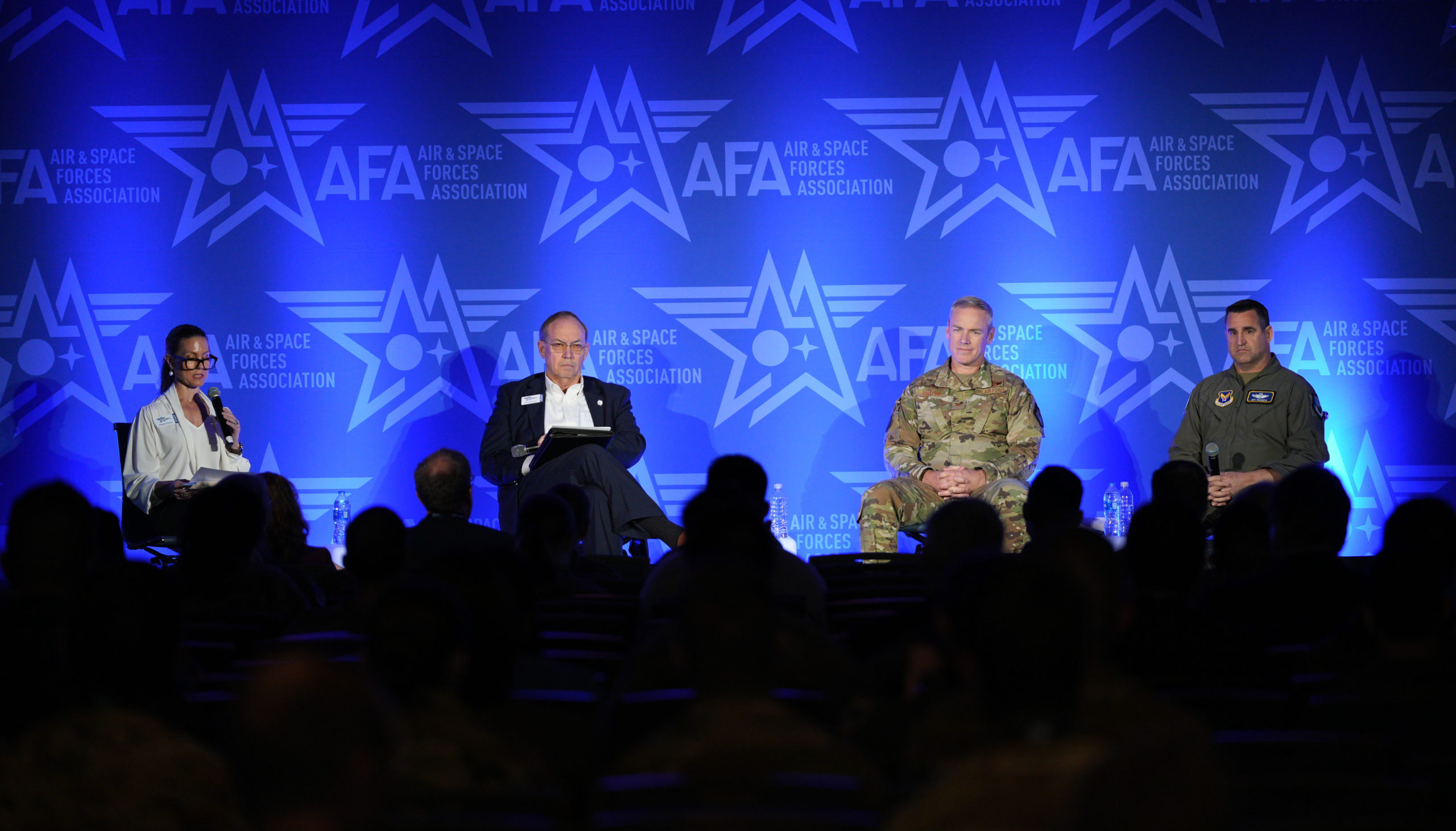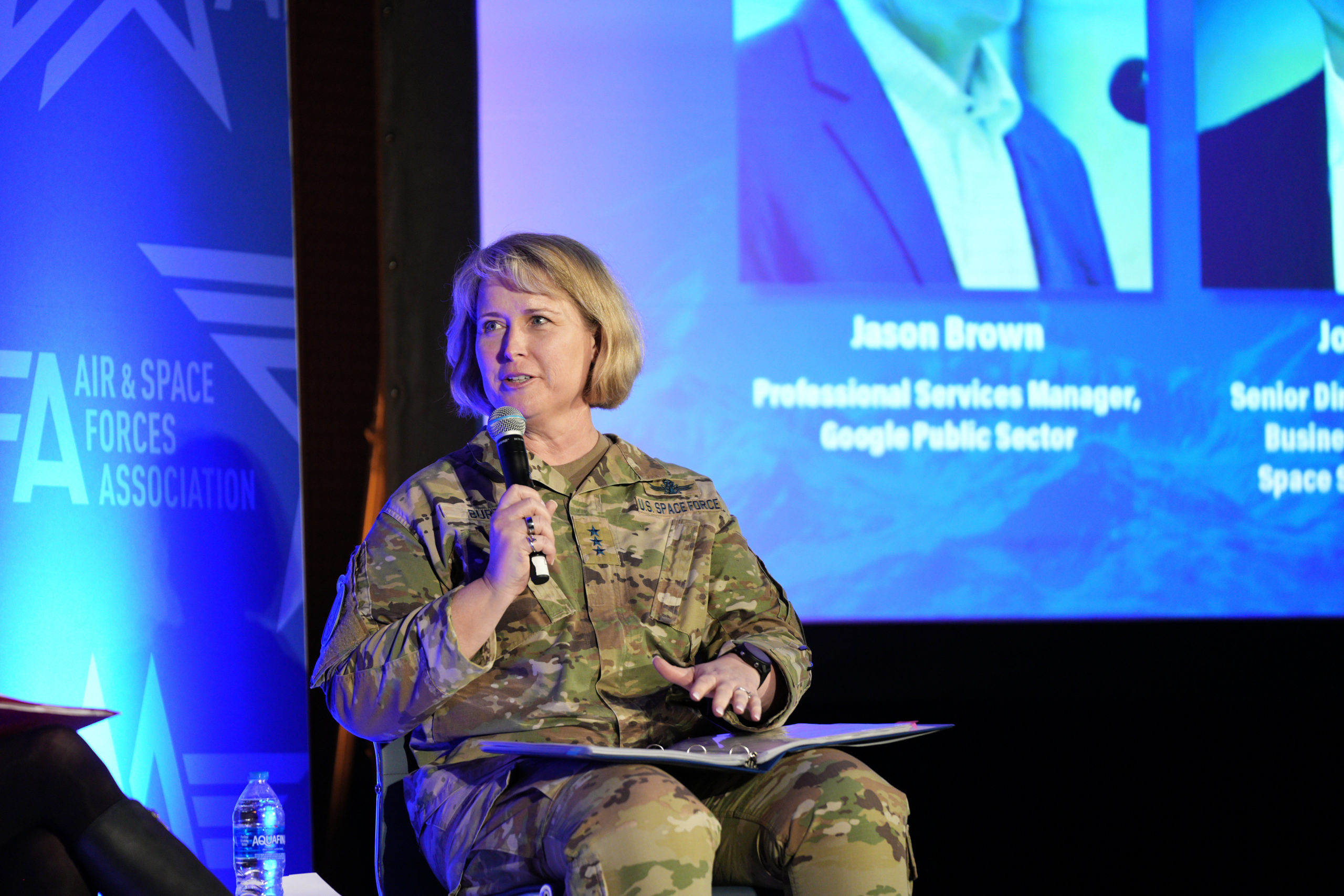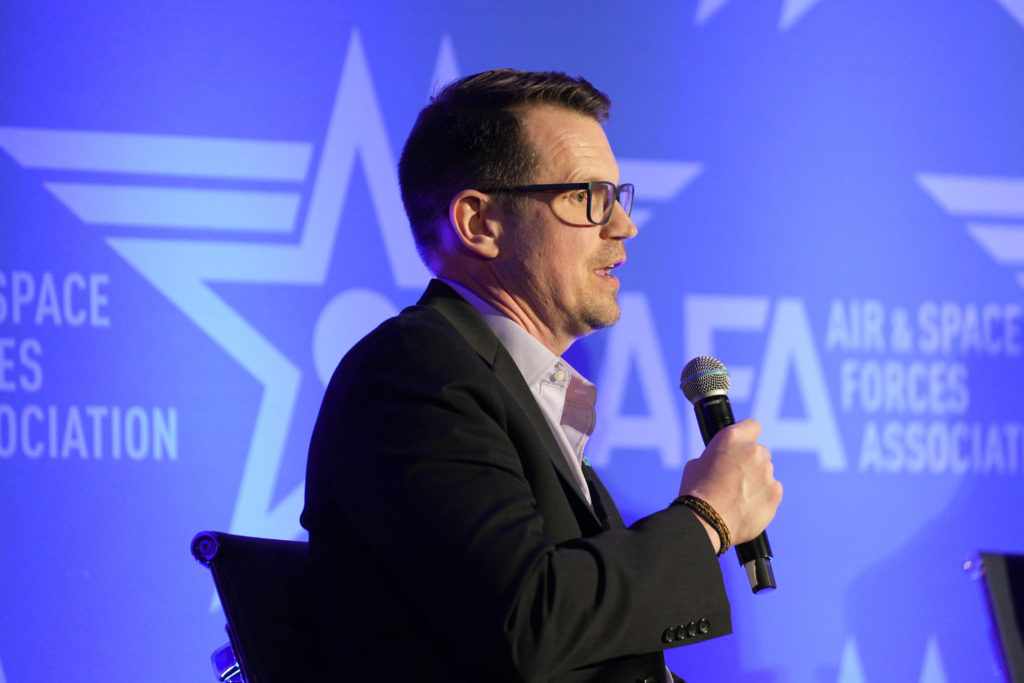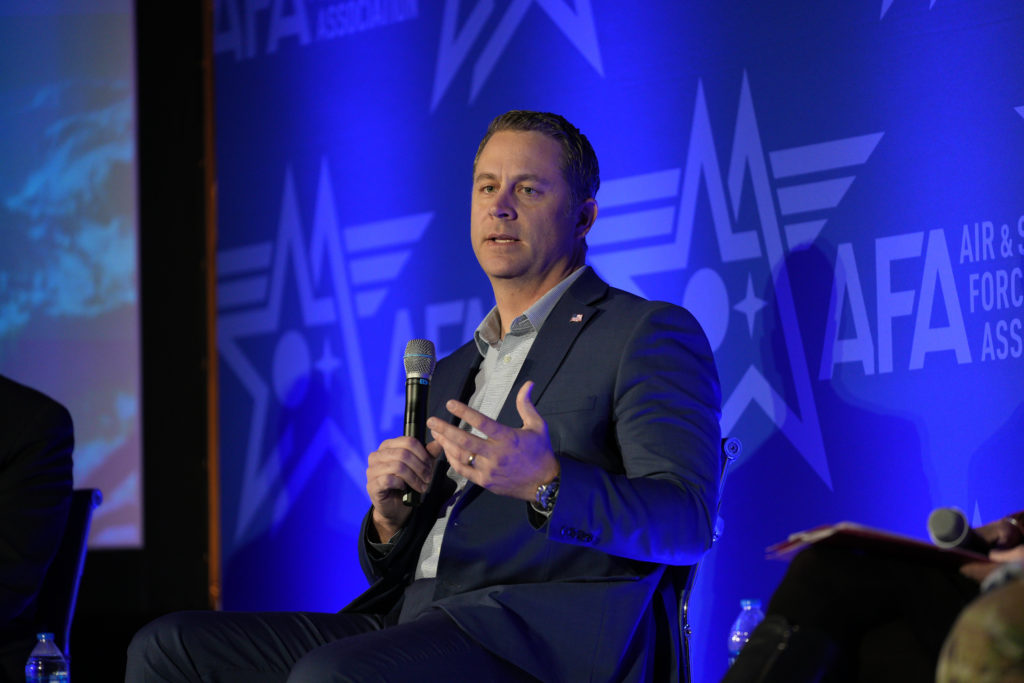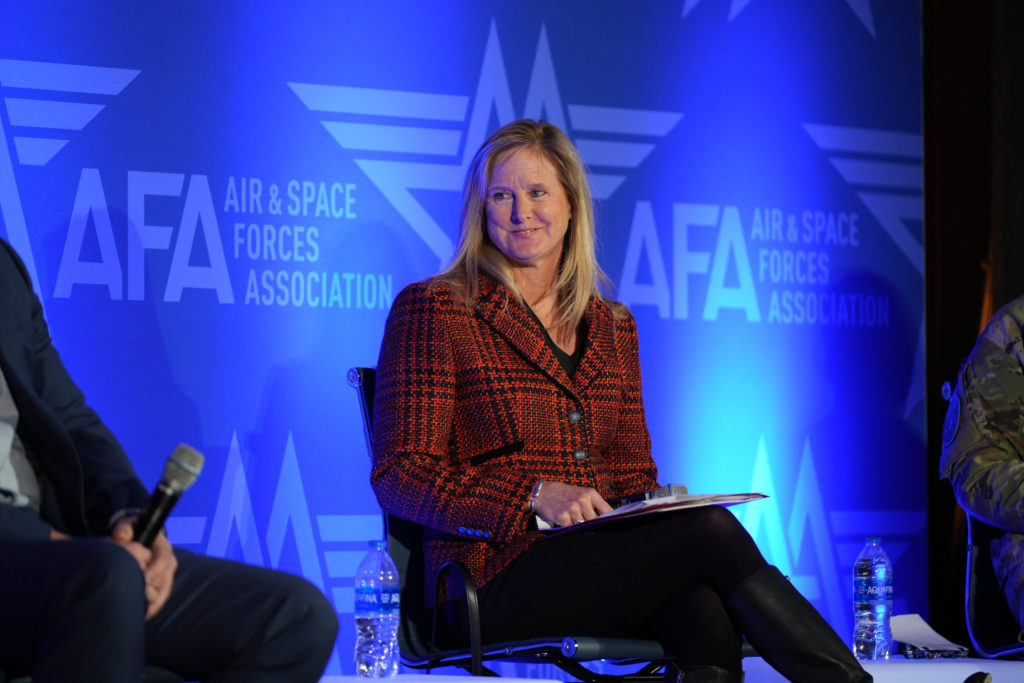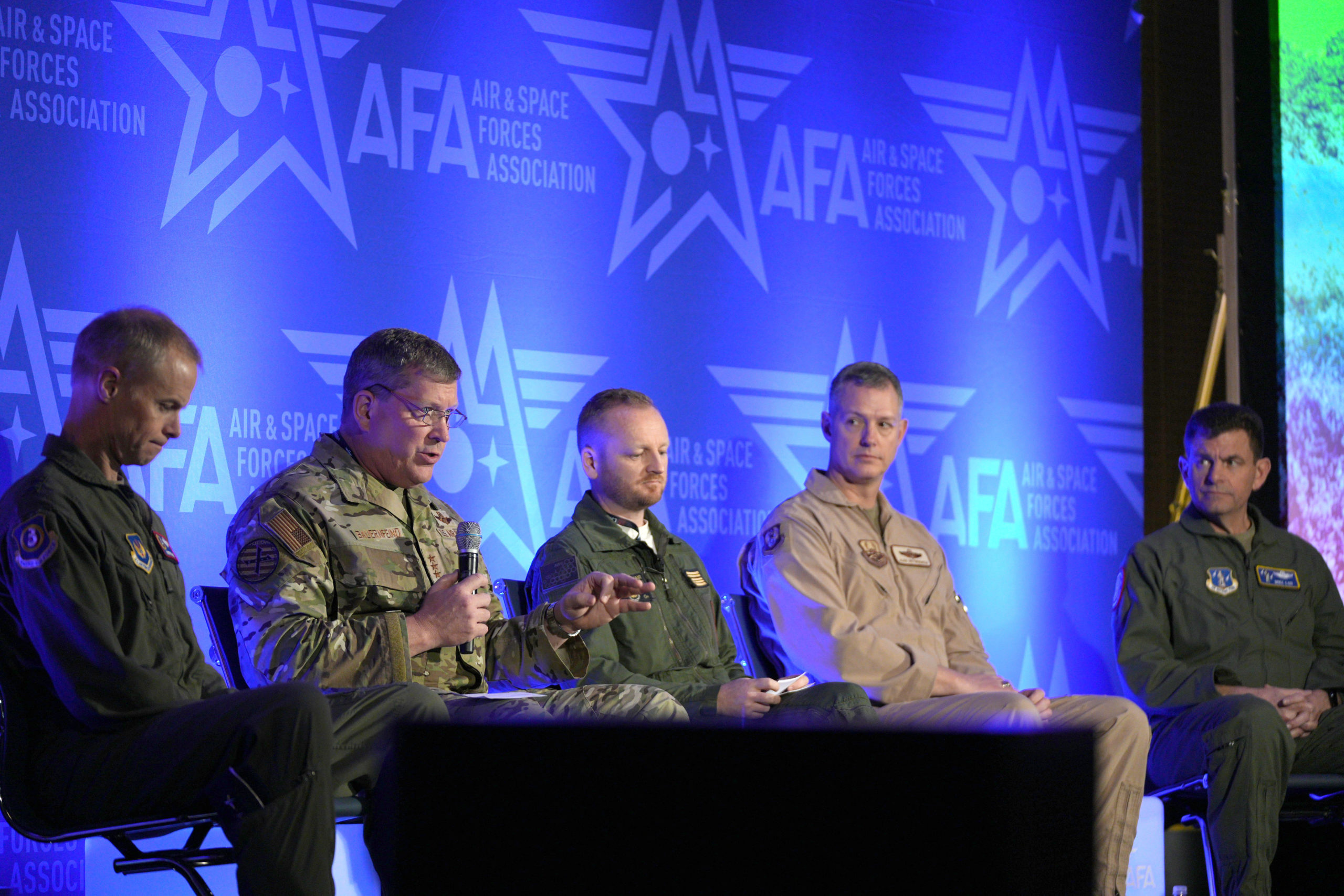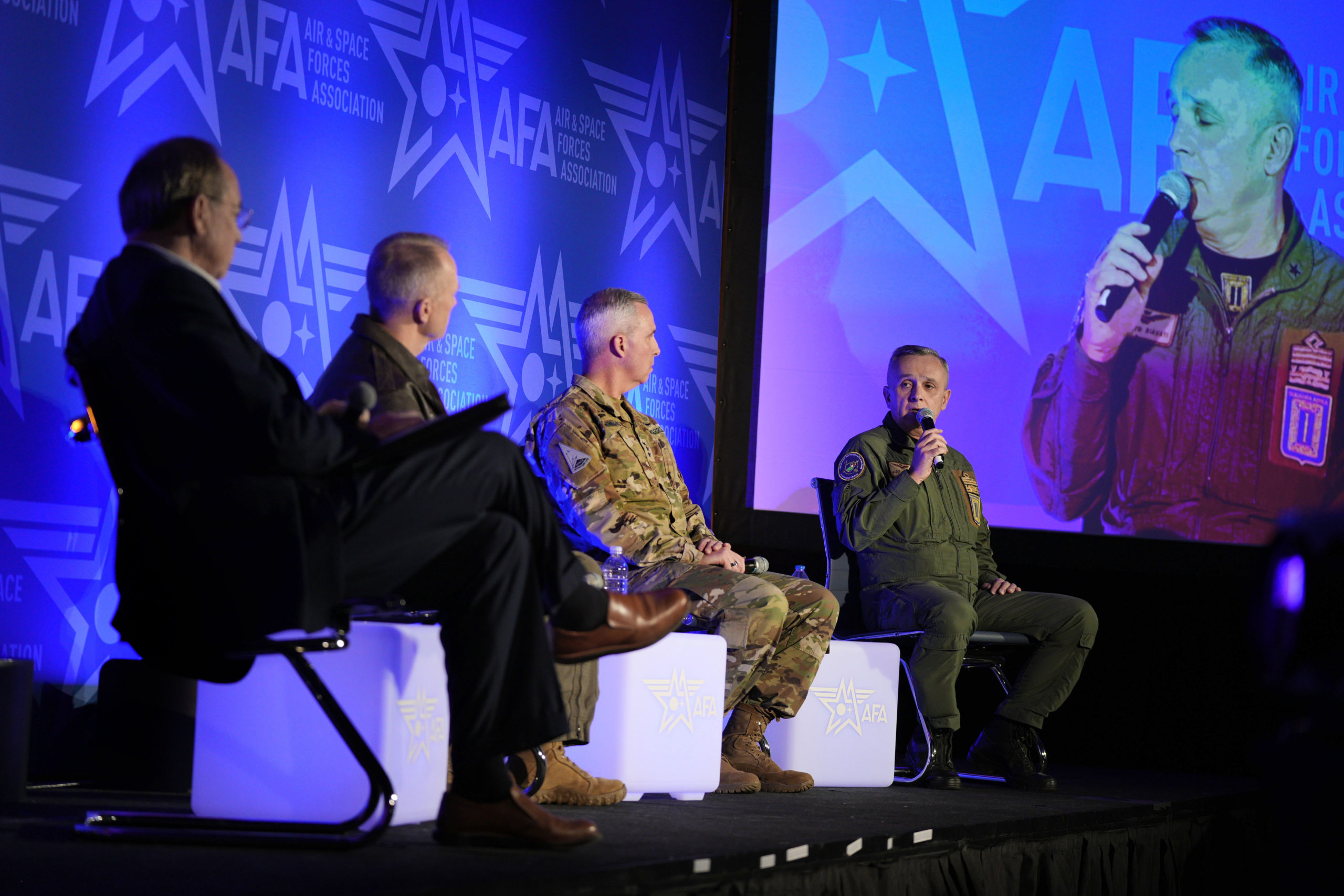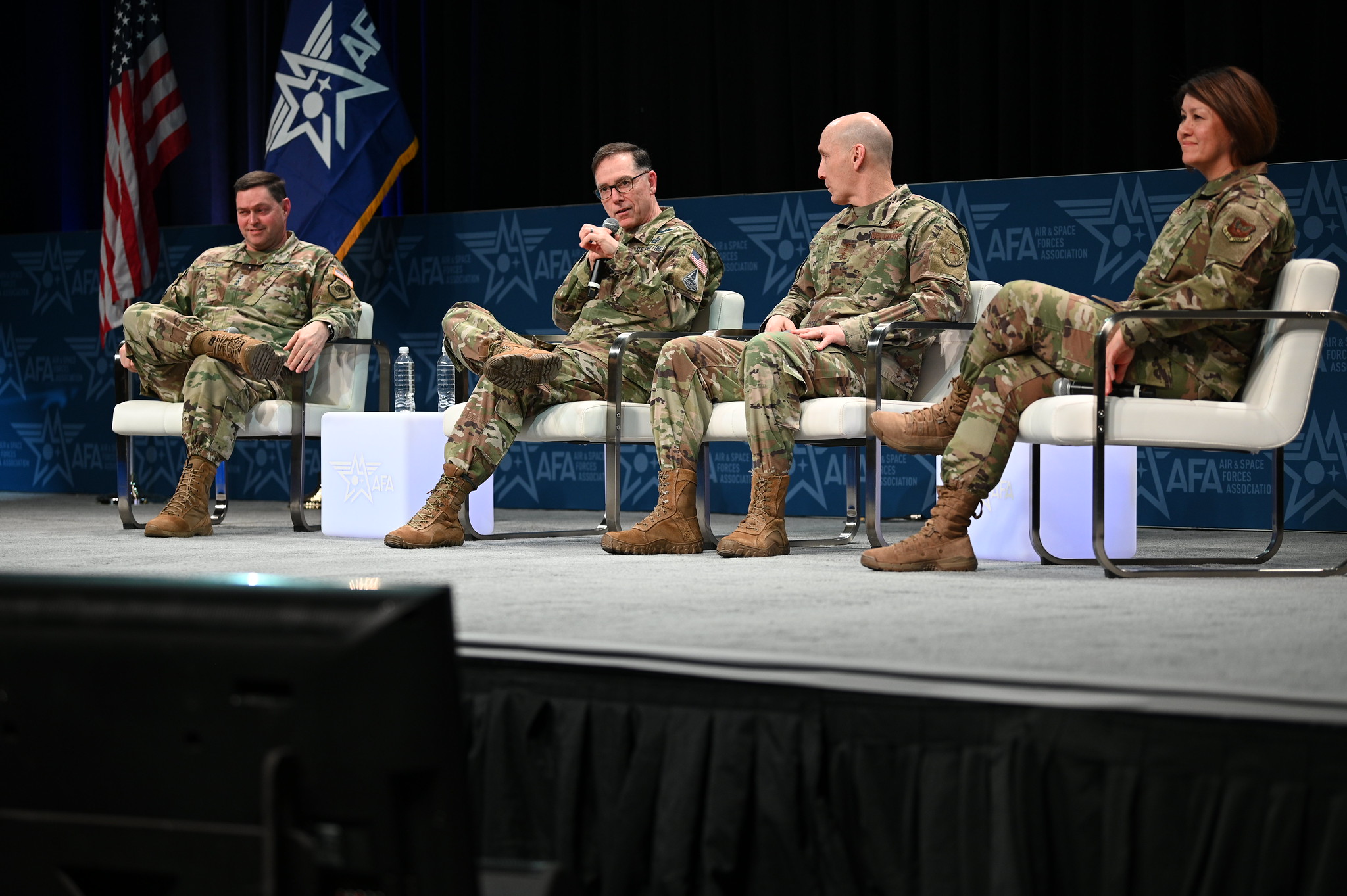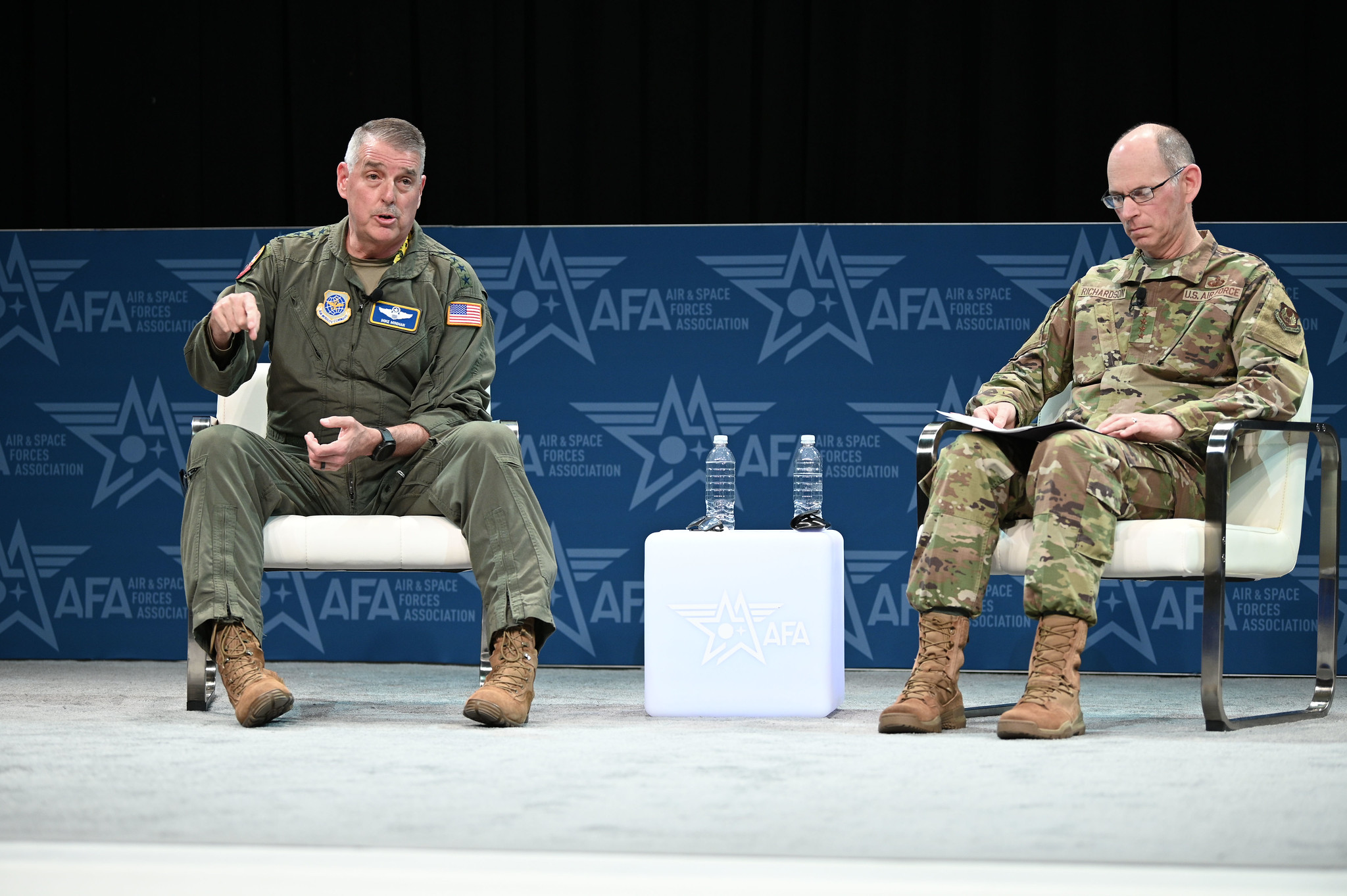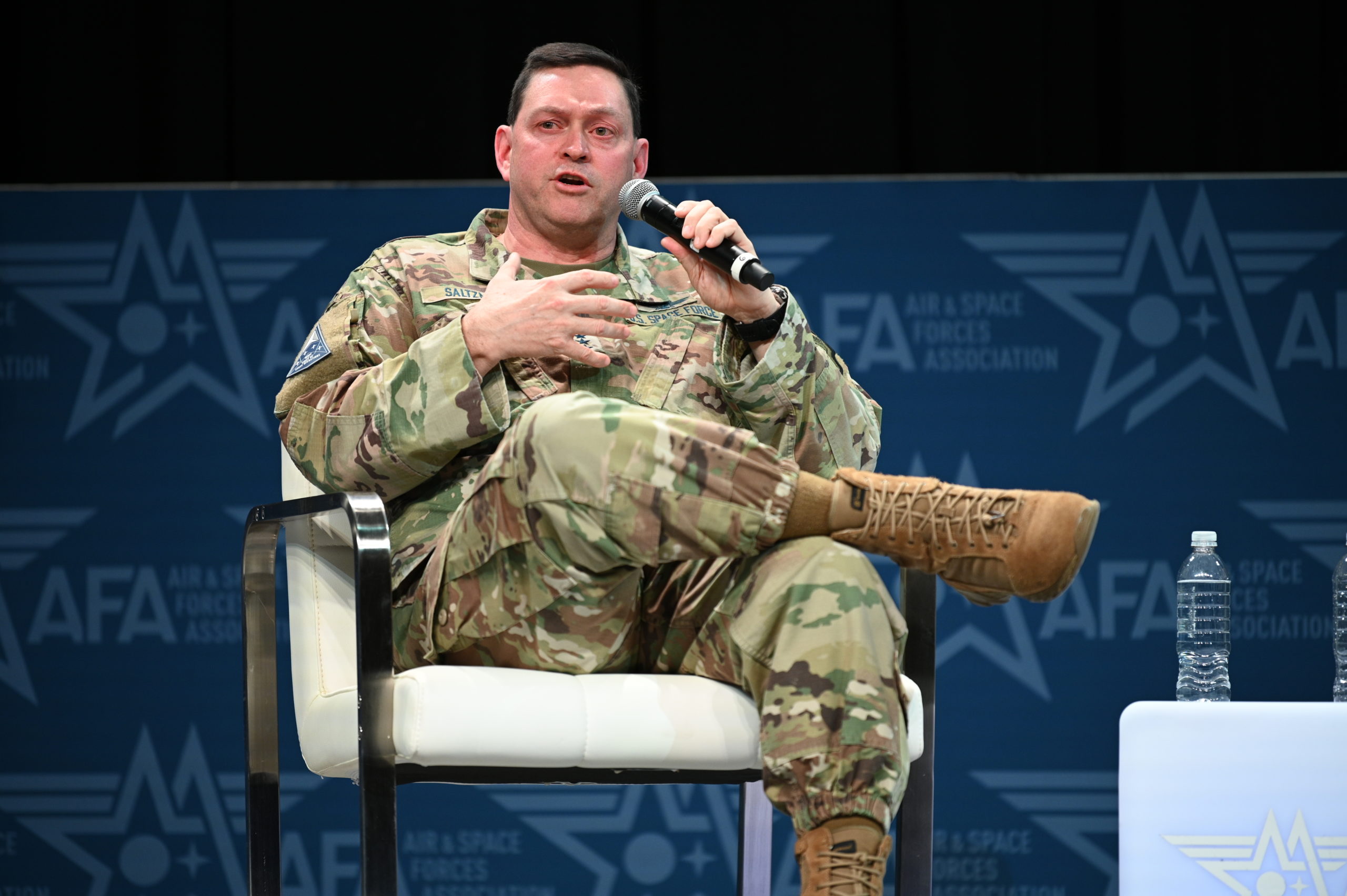Retired Maj. Gen. Kimberly Crider, former mobilization assistant to the Chief of Space Operations and Acting USSF Chief Technology and Innovation Office, oversaw a panel on ‘The New Air Operations Center’ with Bill Torson, warfighting architect for Kessel Run; Col. Alan “Doc” Docauer, chief of command and control/intelligence, surveillance, and reconnaissance operations for Air Combat Command; and Col. Frederick “Trey” Coleman, commander of the 505th Command and Control Wing, at the AFA Warfare Symposium on March 7, 2023. The panel talked about how new technologies and challenges are driving the Air Force to reconsider how it approaches command and control. Watch the video or read the transcript below.
Maj. Gen. Kimberly Crider, USAF (Ret.):
We got you. Thank you so much for being here. Wow. I’m glad you guys all found us. This is a great group. I think we’ve almost got a full house here. Talking about the new Air Operations Center. I’m so excited that we’ve got such an eager audience to be part of our conversation today, and I’m really thrilled to be the moderator of this particular panel. Let me just briefly introduce myself, and I’ll introduce our panel members, and then we’ll jump into this interesting discussion. So I’m Kim Crider, retired major general. I retired in 2021. I would say that command and control has been kind of a core theme throughout my entire career. I started my career out in acquisition, and I was actually working at Hanscomb Air Force Base when we first created the AOC Weapon System, way back in the day.
Throughout my career I’ve been involved in not only the systems engineering design and acquisition of command and control systems for air operations across and around the globe, in Europe, in the Pacific. I’ve been involved in requirements and capability planning for command and control. I’ve been involved in air mobility command and control, as well as in cyberspace operations and space operations. So I think I had a pretty full rounded career, and really got to see how the Air Operations Center has evolved, how air operations has evolved, and how it’s integrated with other joint operations and with the integration of space and cyberspace. So it’s been a phenomenal evolution to watch, and it’s continuing to grow and evolve. And that’s what we’re going to talk here about today.
Let me introduce my panel members. Colonel Trey Coleman, on my left, is an Air Battle manager that currently serves as the commander of the 505th command and control wing at Hurlburt Field. The 505th is responsible for testing, training, and developing tactics, techniques, and procedures for C2 systems from JTAC to JFACC. Trey has also commanded the 609th Air Operations Center at Al Udeid, and the 961st AWAC Squadron at Kadena. He’s published several articles on C2 throughout the Marshall Institute and Air University, and is one of the most senior C2 subject matters in the Air Force. Thanks for joining us, Trey.
Seated next to Trey is Colonel “Doc” Docauer. Doc is the Chief of C2 and ISR Operations at Air Combat Command Headquarters. He’s a career air battle manager with combat experience in the E-3 AWACS, E-8 Joint STARS, and control and reporting centers. He is one of the architects of Comax BMC2 Roadmap, which is transitioning the legacy USAF Theater Air Control System to an ABMS JADC2 enabled C2 system for our air component commanders. Further, he’s one of the tri chairs of Comax Air Operation Center evolution effort seeking to design and field the AOC of the future, and the goal of ensuring the effectiveness and resiliency of the Air Force operational C2 in the face of challenges posed by adversaries such as China, Russia, North Korea and Iran. Doc, thanks for being here.
And last but not least, Bill Torson. Mr. Bill Torson is a pilot with a non-kinetic operations background, currently serving in the Air Force acquisitions community as the war fighting architect at AFLCMC/HBB Kessel Run. Kessel Run is the system program office for the AOC weapon system and six other wing level targeting and operational C2 programs. As the war fighting architect, Mr. Torson engages with industry, the war fighting community, and government technologists to develop a model-based system architecture for Kessel Run’s programs of record that reflects the future of warfare. Bill, thanks for being here.
All right, so with this great panel, let me just give us a little bit of a backdrop. Command and control, as we all know, is a core Air Force mission and joint function. It underpins every operation in our ability to deliver decisive effects at the operational level of war. The United States Air Force has been effectively executing operational C2 via the Air Operation Center for some 30 years. As an operational C2 weapon system, the AOC has served us well. It’s the centerpiece of prosecuting theater war. And while the AOC has certainly evolved over the years, we find ourselves at the next inflection point. Changes in technology and changes in the operational environment are driving doctrinal changes in the conduct of modern warfare, particularly with respect to command and control, which in turn is driving the next evolution of the AOC, to keep pace with future operational demands in an increasing complex and challenging environment.
Today’s panel will explore the changes affecting the AOC, the types of innovation that are driving the AOC evolution, and the operational C2 challenges yet to be faced by the AOC of the future. So Trey, I’m going to to turn my first question to you. With that as a backdrop, and with everything that you’ve done, you’ve had such a great career and influence in thought leadership relative to command and control, operational command and control, and the future of the AOC. Can you give us some thoughts in thinking about the doctrinal changes that we see going on, and specifically how does Mission Command doctrine change the role of the AOC?
Col. Frederick “Trey” Coleman:
Thanks, ma’am, for the question, and thanks for the audience. Thanks for being here. It’s amazing that the house is so packed, and that’s just a reflection of how important the AOC is and how much we think about it and how important it is to the way we fight. I’ve got this theory, and the theory goes something like this. And if you’re a major going off to IDE next year maybe, and you’re looking for a research paper, I’m looking for somebody to write this out in a professional way. But here’s the theory. It’s that there’s an inverse relationship between the size of our force and the need for C2. Particularly the type of C2 that is resource management that happens at the Air Operation Center. There’s all sorts of different types of command and control at all the different levels, but I’m talking about kind of operational level command and control that figures out what assets are going to what place at what time, what they’re doing, who’s getting the assets. That’s essentially resource management.
And that is what the AOC does on behalf of the air component commander, on behalf of the combatant commander, under the authorities of the Secretary of Defense. And so today, with a force as small as we have today, we need that function more than ever. If you think about World War II, we had about 300,000 airplanes in the inventory in World War II. 300,000 airplanes. And think about the C2 structure and the C2 capabilities back then. Certainly there was somebody making decisions and doing some resource allocation, but technologically there just didn’t… Once those airplanes took off, there wasn’t much there. Very nascent radar, very, very nascent radio capability. And so they didn’t have much C2. But they had a ton of airplanes. And if a mission took off and came back with half the bombers, that was not desired, but you could accept that, you could tolerate that and you can keep fighting. We cannot do that today.
When you think about Vietnam, Vietnam had 17,000 airplanes in the Air Force inventory, about seven or 8,000 fighters alone. And we had what I would call a first generation C2 enterprise. You had the EC121, you had some ground control stations, and we had some basic command and control capability, a first generation C2 capability. And then came the 80s and 90s when we delivered the AWACs and the JSTARS. And the AOC was kind of the culmination of our C2 delivery in the 90s that folks like yourself helped build. And it was really revolutionary. Think about, without that Air Operations Center, without that function, who was deciding what airplanes were going where at what time, when they were meeting up, what their mission was, who wasn’t getting the resources, what’s the strategy, who’s doing the targeting? How did those functions exist? And so the AOC was pretty revolutionary. And I would call that our second generation C2 force.
And then we stopped. We stopped. And so we have a second generation C2 force that culminated in the 1990s, and we have a fifth or sixth generation fight. And so we got to catch up. This panel is about the AOC, but we’re doing it across the board, and DOC and ACC are doing a great job with the BMC2 roadmap. It’s really helping usher us to the next generation. But we got to skip a few generations. We can’t go to the third generation, we need to go right to the fifth or the sixth. And so it’s challenging. But this panel focused on the AOC, I’m going to focus my comments on what we’re doing to bring across, to bring about the new AOC.
And we do it, you asked about Mission Command, doctrine is driving a lot of these changes. Mission Command is not new, but it is new to doctrine. It is a new focus for us, how do you execute Mission Command? I’ll give you an example of how we did it when I was at the 609th. At the 609th, in 2019 we issued mission type orders to AFA in Afghanistan, and we said, “Hey dude, you guys have all the resources you need. You got two fighter squadrons, a tanker squadron, some MQ9s, C130s. We’re really focused on these things over here in Iraq and Syria and Saudi Arabia. And so you guys do your thing, and just let us know what you’re doing, we’ll put it on the ATO, and you guys go execute.”
If you flew out there, you knew it’s a four hour drive time anyway, to get from central Afghanistan to anywhere in the Gulf where you’re usable. And so we gave them the MTOs, they executed, they did their thing, and it worked pretty well. But they didn’t have enemy IADs to worry about. They didn’t have to have a big EW requirement. It was pretty simplistic targeting on behalf of US4A. And they had the ability to have that relationship right there.
And then we started pulling tankers away from them, because we needed them in Iraq and Syria. And the whole MTO thing just kind of unraveled, and it unraveled very quickly. And then when we pulled one of the fighter squadrons out, it just, we had to stop and we rescinded the orders. What we learned from that experiment was that the way we were trying to use mission type orders in that case was to replace the functions of the air component. And unless you have an entire Air Force, a composite wing the way that they did at the time, you need the functions of the air component to give you the resources. And the more they needed the resources, the less MTOs work to replace those air component functions.
So our big takeaway was, that’s not really the best use of MTOs. MTOs are great at the tactical level. Mission Command is what we need at the tactical level. That’s how you do decentralized execution. Give the AW the authorities to park his jets wherever he wants under an ACE construct. As a matter of fact, I don’t think the ATO should even say where you take off from. I don’t care, as long as the airplane gets to the right place at the right time. So that’s what Mission Command should do, give the AWs all the authorities they need to defend their bases and move their assets around. But they don’t replace, Mission Command does not replace those resource management functions that happen in the Air Operation Center today. So that’s kind of my opening salvo. I’m excited to be here, and looking forward to this conversation.
Maj. Gen. Kimberly Crider, USAF (Ret.):
Very helpful. Doc, do you want to jump on that?
Col. Alan “Doc” Docauer:
Yeah, sure. I completely agree that if you think macro, decentralized execution as our joint doctrine and our service doctrine is overarching approach that really gets back to the American way of war, where Americans execute a mission, and the Airmen on the battlefield and our soldiers, they recognize opportunities and they act on those opportunities. That’s why we have the flexibility and the ability to take advantage of those in comparison to some of our adversaries.
You remember back in the Cold War, that was always the comparison between the Americans and the Russians. The Russians, they don’t have any authority, they can’t do anything but what they’re supposed to do. Americans, we can think and we can act. And I really think that tie to commander’s intent is really important. And at the decentral execution level, the way we’ve done that in the past is, hey, you read the AOD, you read the spins, you understand as much as you can about the commander’s guidance and intent and do your best to stay aligned. And I just think that Mission Command and mission type orders really help to understand the commander’s intent at a deeper level in the transition from the operational to the tactical level.
And that’s why I think it’s so absolutely critical. Because we have to get back to thinking, and acting, and taking an initiative, and taking advantage of opportunities on the battlefield. Because it may be the difference between winning and losing, as it was in the past. And we need to evolve past the 5,000 mile screwdriver, which we’ve gotten very, very good at over the last 20, 25 years of war. And maybe that our Airmen today don’t completely remember how to exercise initiative like they did in the past, because those Airmen have retired and moved on. And we’ve got to go and train every day and our exercises, our daily training, our OREs, our ORIs, to think and act like that. So from that perspective, what General Brown said earlier about mission type orders need to be executed at every level at every training event, that’s what he’s talking about. We need to go relearn not only the nuts and bolts of Mission Command and how to develop and execute a mission type order, but we need to go relearn how to take initiative on the battlefield. Okay.
Maj. Gen. Kimberly Crider, USAF (Ret.):
Thanks very much. So pulling back to the operational C2 level then, right? Let’s talk about another important concept and function of the AOC, which is to produce, process, and execute the ATO, the air tasking order. So as we think about the AOC of the future, what changes do you envision, Doc, to how the ATO cycle may work? Do we see anything happening there?
Col. Alan “Doc” Docauer:
So that’s an interesting question. And I think that it’s almost… And there’s some AOC commanders, AOC leadership out there, almost everybody asks that, right? But let’s just be clear, in the past we’ve made adjustments to the ATO cycle based on the needs of the mission. Great examples of that manifested around the summer surge in Iraq in 2007, 2008 timeframe, when the land component commander just wasn’t being serviced by the length of our ATO cycle, and our ability to effectively stay in tune with the JTAR process. So we compress the ATO cycle. So I don’t think that the joint air tasking cycle or the ATO cycle is static. I think it’s very much mission dependent, and episodic based on the needs of the combatant commander, the component commander, the war fighters, and your supported units out there in the field.
That said, people talk about ATO execution, they think about ATO execution and combat ops. But it actually takes time, resources to develop strategy to turn strategy into a plan, allocate resources that plan, enable all the planning across the force, pulling tankers’ fuel together, resources, logistics, generating fighters, generating tankers, building bombs, all that kind of good stuff. That stuff takes a little bit of time too, okay? So you can’t just assume that we’re going to execute a 12 hour ATO cycle. Because all that other planning, directing, controlling, assessing air power, all that other stuff besides just executing is important too.
But do you think that the place where there’s room for a lot of thought, and there’s been some thought in this arena, and we need more, is things like multi-day ATOs, and standing guidance out there in the field to enable the initiative at the tactical edge to execute when the ATO didn’t drop on time. Because we still need to generate air power, we still need to stay in the fight. And good, bottom up, your fighters launched, they have to go somewhere, they have to talk to somebody, and pull together some kind of plan, generate a mission package. So good processes, procedures, training, and doctrine all the way through that we can exercise in our major force exercises to be able to do those things on those times or those days when the CDO environment gets ahead of our ability to generate an ATO.
Maj. Gen. Kimberly Crider, USAF (Ret.):
Great. So as we’re trying to generate the ATO with a certain amount of flexibility, and move in fact towards maybe multi-day ATOs, Bill, help us think through a little bit, and Doc, maybe you can jump on this too, from an AOC weapon system perspective, the a C2 system itself… I mean, the ATO is dependent on data. And all of the systems across the AOC are dependent on data, and the need to be very collaborative across all of those different functions. So how is the C2 weapon system evolving in the AOC of the future to be more collaborative and data centric?
Bill Torson:
Great question. I love that question, and thanks for having me. This is what we live at Kessel Run at the SPO. And as we think about how we do this better and we talk about the potential for a multi-day ATO, or an ATO process that changes, or potential delegated authorities that move further down the chain in a contested environment, our job in that is to create opportunity for the process to change with technology. And a lot of the way that we’re doing that, first of all, I think speaking to what the chief talked about earlier today, and what the secretary talked about, one of the things that we’re doing very closely with our partners at C3BM is making sure that we are building to a model-based systems engineering standard that supports the greater ABMS construct.
Because when we talk about data centric, that’s all fine and good, and it tends to be hand wavy. I think we all know that. Where, “Oh, it’s about the data. It’s about the data.” Well, I agree with that. But fundamentally, what are the human workflows that we are enabling, and how do we enable those successfully using data? So it’s not about data in general, it’s about specific things we can know.
One of the things that we’ve learned in studying the AOC that goes into what it takes to shorten an ATO cycle or make it more adaptable, is that a lot of the time that goes into the development of the ATO is coordination and collaboration time. It is emails, it is hundreds of phone calls between an LNO and a supporting wing command post. “How many planes are available now? How many planes are available now?”
As we dig back into that and we start treating our wings, our joint partners, our coalition partners, our friends and partners who operate at different classification levels that don’t always make it directly into an ATO but need to be coordinated with, especially when we start talking about non-kinetic operations, when we start talking about EW and space and cyber and how those integrate into the overall picture, we’re really developing a view of data that allows those teams to be, I’m going to use a term from the 80s that probably died, but a prosumer. A producer consumer sort of hybrid where it’s their job to ask for things, and to provide resources that support the overall development. They do their own work, but they also support a larger system. So looking at all of those teams equally as producer consumers, or prosumers, helps us think about what data needs to be exchanged to make them successful.
Maj. Gen. Kimberly Crider, USAF (Ret.):
Sounds great. I love that. Prosumer, right? That’s our new word for the day.
Col. Alan “Doc” Docauer:
Let me write that down. Just pulling up just a little bit, I think, so how do we get to a collaborative environment across our C2 system from JFAC to JTAC? And I think that is a key to really executing things like sensor to shooter in a meaningful realistic way, all the way through the targeting process, and the decision cycle, and actually getting a decision, coordinating out there in the field, but automating some of that. But it is really about the quality of the data. But it’s not just the data, but feeding in as much data as you can from as many sources as you can, including our allies and partners. Not just giving our allies and partners data, but getting data from our allies and partners is a baseline. But then you got to have the application layer, where the workflows that are going to execute that data kind of manifest.
And then, how do you make sure that what’s happening in AOC is collaborative with what’s happening in a CRC, and on an E7, and with a JTAC at the tactical edge? So these tools and processes that we’re building, we have to share code, share software, share processes, and make sure things, open architectures, and data standards, and things like that are consistent across the board, so that we’re able to stay synchronized. And make sure what our operators, whether at the wing using CHIMERA, at the AOC using Kratos, or in a BCC using CBC2, they’re all able to see the same data. Maybe specifically used by the operators a little differently, but the data is leveled, so it’s a democratization of that data.
And then pulling up another level, so to facilitate that you have to go to the cloud. So moving everything into the cloud is really kind of… So feed in as much data as you can, and collaborative application layer, shared data, shared code, shared applications, and then a cloud to pull it all together. There’s some risk management there with edge computing and things like that. But at the end of the day, you really have to have those three things. And at the very tippy top you better have a resilient communication layer to be able to move all that data from where it needs to be, from where it is, and be able to protect it at the same time. So there’s a lot to dig into there, but that’s really kind of the four things we really need to get after to get after that collaborative environment. Trey?
Maj. Gen. Kimberly Crider, USAF (Ret.):
Yes, that’s great. And Trey, let me pull this back to where we started a little bit with you. And Bill mentioned it, so an important aspect of the collaboration, of course, is collaborating with the wings, at the wing level. And to your earlier point, I mean, MTOs, Mission Command, push that down to the tactical level. But AOC still wants to coordinate and collaborate with those wing level units. So how do you see the C2 system of the future facilitating that collaboration to support distributed or decentralized control?
Col. Frederick “Trey” Coleman:
That’s a great question. The distributed word there is one of the most fundamental changes to doctrine that we’ve seen in a long time. We went from centralized, controlled, decentralized execution, and then we separated command and control, and now we’ve transitioned, under General Brown’s… during his time as a chief of staff, to we’ve transitioned to centralized command. Because a commander, a single commander needs to have those command authorities to distributed control and decentralized execution. This distributed control thing is what we’re talking about.
As a historical reference, I’ve used this before, so if you’ve heard it before, humor me. In 1929, the French started building the Maginot Line based off of the lessons learned in World War I. And it was a beautiful structure, spans 200 something miles, tons of command bunkers in there, and tunnels, and hallways. It was fantastic, and it would’ve worked really, really well in World War I. They spent $9 billion on it in today’s equivalent funds, by the way, and took 10 years to do it. And the Germans walked around it in eight days.
And I’d argue that our AOCs are built on the Maginot Line business model. Now, the difference is they’ve worked really well for 30 years. They have really been successful for us. They’ve revolution revolutionized the way that we C2 air power. But they’re not going to work in the next fight. And so we’ve got to get away from the Maginot Line business model, and get ourselves into the Uber business model. And that’s what distribution is all about. That’s what we’re trying to do here. It’s not necessarily a new idea. I mean, COVID showed us how it can be done. Essentially it’s remote work, that’s what we’re talking about. It is revolutionary. It’s a new idea for the air component.
And it’s really uncomfortable, because we all like having all our people in the same room. And by the way, we’re built, our C2 systems today, both at the operational and tactical level, are very much built to be centralized. Not only are the people in this big gigantic, hundreds of billion dollars or hundreds of million dollar building, but the data’s there too. So we all have these beautiful data centers in the basements of our air operation centers, and the data can’t get out. And if the data can’t get out, it makes it really, really hard to distribute. And so while we talk a lot about the cloud, we all know we need to go to the cloud, I think that one of the things we’re going to have to do from our enterprise level is incentivize getting our air components to transfer their data to the cloud. That’ll be an important step for us.
But once you’re in the cloud, how do you do it? There’s some really good examples out there of folks who are doing it already. AFSN’s probably leading the way with distribution. There’s other examples. I’ll give you a couple of examples that are a couple years old, and one that is as of a couple weeks old. When I was at the 609th, we were transitioning a lot of our forces to our alternate location, to the AFSN headquarters at Shaw. And so we had the ability there, we were pushing the ATO from our facilities there. And then as tensions kind of escalated with Iran, we put some of our combat operations capabilities there too. And so, we were in any given day performing a senior defense position, air defense duties from Shaw, and offensive operations or chief of combat ops from LUD, or vice versa. You could conduct the entirety of the entirety of the strategy mission from Shaw. So there’s some distribution there.
I was talking to General Grynkewich the other day, and he said now that they’ve transitioned fully to Kratos, they’re not using TBMCS and FTK. Because the way we were doing it back then was just a VPN tunnel. So you had the VPN into the system at LUD, and there’s latency, and it’s not very good. And so, but it was okay. It was better than what we were doing before. But now that we’re using Kratos, which is entirely cloud-based, I guess they pushed the ATO from an apartment complex as a… They decided to just not go to work that day, and they pushed the ATO from an apartment complex in Sumter, South Carolina.
That’s distribution. This stuff isn’t science fiction. It’s real, and we’re doing it. But Kratos is just the first step. It’s one really important system that’s a part of the Air Operation Center, and there’s a whole lot of other systems that we’ve got to get to the cloud, and a lot of other data that we’ve got to get to the cloud, so you can do this with any of the systems and any of the functions that you need to perform inside of the AOC.
Maj. Gen. Kimberly Crider, USAF (Ret.):
Thank you so much. That’s really helpful.
Col. Alan “Doc” Docauer:
Mind if I jump on that real quick?
Maj. Gen. Kimberly Crider, USAF (Ret.):
Of course, go ahead, Doc.
Col. Alan “Doc” Docauer:
Yeah, I know you’re trying to move on. I think one thing that is misunderstood about distributed operations, distributed control, is the bean counters here that, and they think efficiencies. They think, “Hey, if we’re going to distribute our operations, it must be more efficient, therefore I’m just going to take my cuts, and then you guys can figure out how to account for the cuts down the line.” And we see that manifest in things like the AOC consolidation discussion, which is out of sync with the manpower deficiencies we have in the system. But really, distributed ops is about resiliency.
Now, it’s up to a component commander working with their combatant commander to find with their requirements for resiliency are. That could mean distribute forward, distribute rear, distribute to your TFI units, whatever, or some kind of combination. But the point is it’s really to enable that resiliency. As an additional step to the protected COM, you also have to be able to protect and assure your operation. So distributed ops is about being more effective, it’s not about being more efficient. And I think if you get a chance to communicate that to everybody who wants to take a cut, that would be helpful to our cause.
Maj. Gen. Kimberly Crider, USAF (Ret.):
Great, great point. Thanks for adding that. So the C2 system of the future, the future AOC, very focused on providing an infrastructure that facilitates collaboration and distribution, which adds to resiliency. Bill, I want to circle back on one of the other points that you made, which is coalition partners. So in this new environment that we have to operate in, we know how critical our coalition partners are to our war fighting operations. So how are the coalition partners going to play into this, and access this C2 system of the future?
Bill Torson:
Yeah, this is the tough one today, right? No. So, I think first of all I want to acknowledge upfront that it could not be more clear from our AOC commanders, all the way up through the Chief and the Secretary, all the way up through our most senior leadership, that we go to war with our partners no matter what. And we do that right. So whether it is a policy thing or a technology thing, we’re going to war with our partners. So what it takes to get there is a combination of technology and policy. So in the midterm, there are ways that we are changing the way we build the AOC weapon system from a technology perspective that support coalition partner access.
One of those things is, as opposed to having multiple regionally located AOC, and Trey and I talked about this, the tech stack is in the basement of the AOC, transitioning to a single instance of the cloud-based AOC, which is multi-tenant, meaning all of the AOCs live in one large instance of the AOC, and data is shared specifically based on role and attribute based access. That is important for us, as a US force, to be able to distribute information accurately. I think mobility right away, as folks that are constantly transitioning between AORs, and their data needs to transition with them effectively, we are treating our coalition partners and our joint partners exactly the same way. So their access to different parts of the system is 100 percent based on the reliability of the information, and their roles and attributes based on what they are doing as they operate the AOC weapon system. So that’s kind of the big picture.
In the interim though, we are looking for, and we are getting, a lot of support to policy that supports that kind of work. What we’re talking about from a technology perspective is not something that has been done many times before. So it goes, for the technology people in the room, it’s a zero trust model, which is something the Air Force just put a policy out about on how we’re moving that direction in general. The way we implement that successfully in the AOC weapon system is something that we are lead turning, and not waiting for the Air Force to figure out as a big picture.
Maj. Gen. Kimberly Crider, USAF (Ret.):
Yeah, thank you so much. And you kind of mentioned somewhat of the technology, and the way that technology is really helping to facilitate… Technology’s come a long way to facilitate a lot of these advances and opportunities that we have. We talked about cloud, we talked about better management of the data, being able to tag the data, being able to assign attributes much better, more effective role-based and attribute-based control, and supporting zero trust models. Bill, just to continue that thought a little bit, talk to us a little bit more about Kessel Run, and how you’re using best industry practices and industry innovation to sort of help this evolution of the AOC.
Bill Torson:
Sure. So there’s two things there. One is the industry practices piece, and then the other part is how are we using industry itself? So from an industry best practices perspective, Kessel Run, for those who don’t know, was born out of this idea that industry, especially software, agile best practices are a more successful way to deliver content fast. So the basic principles here being continuous delivery, continuous test, so that we are always delivering new content. So for example, when the 609th transitioned fully to TBMCS, or off of TBMCS, excuse me, into Kratos, you would assume based on an original model for delivery that, “Okay, that’s the baseline. We’re going to let it settle and then kind of wait and see what happens next.” No, in the next two or three weeks there were more than 100 changes to the live production weapon system.
So, this sounds like risk, but it’s not. It is managed risk. And from what we learned from industry, and what we’ve really learned in iterating on this process in government, because it is a very different thing to do in government, is that you actually reduce risk by continuously deploying to your production environment. To the actual weapon system, as opposed to sitting, and waiting, and validating. Now, this has been a journey with our test community, who have been awesome partners in figuring out how to do this well, because continuous test is not something that is generally done. They usually wait until, “Here’s the… You’ve completed the entire requirements document, I’m going to go back, I’m going to give you a zero to 100 score on what you’ve completed.” Well, the idea now is that it might show us a very small percentage, but that very small percentage is very, very narrowly and well done, and we’re going to move to the next percentage after that.
So those practices have been iterative, and we have changed a lot. I think from our original model that was strictly out there, user-centered design, everything is focused very intentionally on the 609th user, we’ve learned some lessons along the way. One of those lessons was kind of the genesis for my position, which is the idea that user-centered design is a beautiful thing if you’re building the Nike Run app for a watch, right? Because your metric for success has everything to do with user adoption. And, “I changed the button to green, and looks like a few more people showed up.” Well, what we find is that user-centered adoption is a beautiful thing when you’re trying to really optimize an individual position, but it really requires a bigger understanding of how the system itself fits together, and how human workflows flow between each other to be successful.
And for that reason, we have come to the conclusion that there is a larger ecosystem, there is more to the solve, and that’s where we really look to our industry partners and our other government technology partners to help us succeed. Now, what we have learned is that building it yourself in all cases is not going to solve all the problems. It’s too big, and it’s too complicated. What we really have to do is understand the model for how it needs to work, and then we need to go out to industry. So we are always looking for industry partners, and we approach that from a very humble position, where we know we need industry’s help, and we want to operate as an internal integrator to a greater ecosystem.
Maj. Gen. Kimberly Crider, USAF (Ret.):
That’s great. Thank you so much. Did you want to jump on that, Doc?
Col. Alan “Doc” Docauer:
If you don’t mind.
Maj. Gen. Kimberly Crider, USAF (Ret.):
Please. I don’t mind.
Col. Alan “Doc” Docauer:
Yeah, so I think the amount of time it’s taken to progress from AOC 10.2 and the failure of that program to where we are now is, I think everybody would agree it’s been too long. And certainly our C MAJCOM commanders and their AOCs would agree, because they’re doing a lot of things on their own to try to get capability in their AOCs. So how do you leverage industry, industry capabilities to kind of form the chocolate and the strawberry and the cream and the icing on the Sunday, if you will, to kind of build on, and be a force multiplier for Kessel Run and Kratos as we work through the very difficult and very challenging issues that are working for the next set of capabilities? And really use that as an accelerant if you will, an enhancement to Kratos when we get it out to the wide audience here over the next couple of years? And I think that’s an important question. There’s a lot of lot to that in terms of how you evaluate those industry capabilities. Maybe Trey’s got some stuff on that.
Col. Frederick “Trey” Coleman:
So part of the 505th command control wing is the 605th test squadron. It’s the Air force’s only C2 operational test squadron. And so everything from JTAC to JFAC, those guys test. And it used to be back in the day you get delivered a programmer record, and it’s gone through DT, and then it goes to OT, and we develop TTPs for, and you deliver it. And if you want to make a change to that, you can put in your form 1592, and we’ll get the change to you in about two or three years, and we’ll develop TTPs for it. That just does not work with software. The greatest thing about… the reason Kessel Run worked so well at the 609th is because the coders were sitting right there next to you, and you go, “I want to change this, I need to change this,” and they did it in 20 minutes or an hour, or whatever. And software has to be like that.
But we’ve got to figure out how to test it too. One of our other squadrons is the ABMS Battle Lab ShOC-N at Nellis. The mission there at ShOC-N is experimentation for ABMS, but this is a new endeavor for us, and so we’ve got to figure out how to take systems that aren’t programs or record, that aren’t really funded, put them there, experiment with them, do DT, do OT, write TTPs for them, and then some air components have them and some don’t. And every time you go to an air component, you go, “Hey, look at this new tool we’re testing out at Nellis.”
And that’s the place to do it, by the way, because that’s the home of the fighter pilot, and that’s where the greatest exercises happen in the world. And so you got to bring your systems to the Battle Lab, test them at Nellis, build the TTPs for them. Then you bring it to the air component and they go, “That’s cool, but I got this system.” And you’re like, “Oh, let’s bring that one to the ShOC.” And it takes six months to get it in there. But it really is an endeavor of influence and relationships, and it’s not the standard business model that we’ve always grown accustomed to, and we’re figuring out how to do that.
Maj. Gen. Kimberly Crider, USAF (Ret.):
Outstanding. Well, thank you so much. I think we’re just about up on time. We’ve got so many more questions that we could ask, and I think it would just really be a great opportunity to get more and more of your insights here. You guys truly are the architects of the future of the AOC on so many different levels. But let me just wrap us up. So as the complexities and challenges in the joint operating environment continue to increase, and joint all domain, C2 continues to become a key source of strategic advantage, we know the AOC must evolve. Today we’ve discussed the impact of changing doctrine, technology, coalition engagement, and industry practices on the AOC, and the opportunities and challenges that must be addressed to ensure the AOC is ready for the fight tonight and the future fight. Thank you, gentlemen, for your insights today, and the focus you bring every day to AOC’s evolution, and contribution to war winning joint operations. Thank you so much for being here.
Bill Torson:
Thanks.
Col. Frederick “Trey” Coleman:
Good job.
